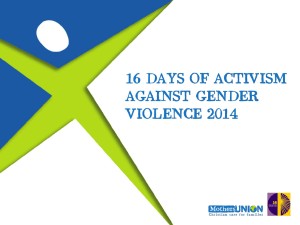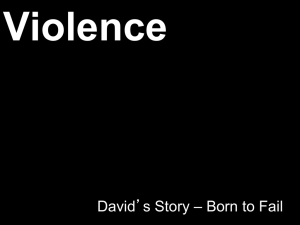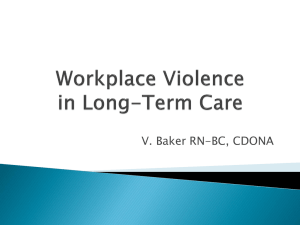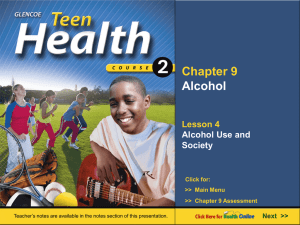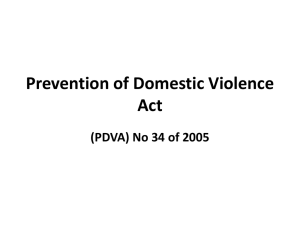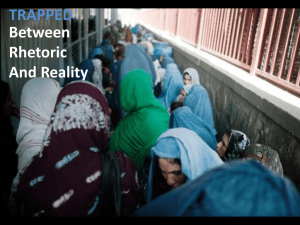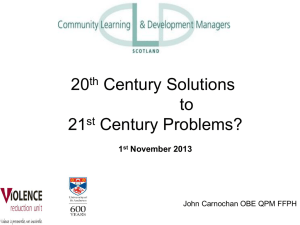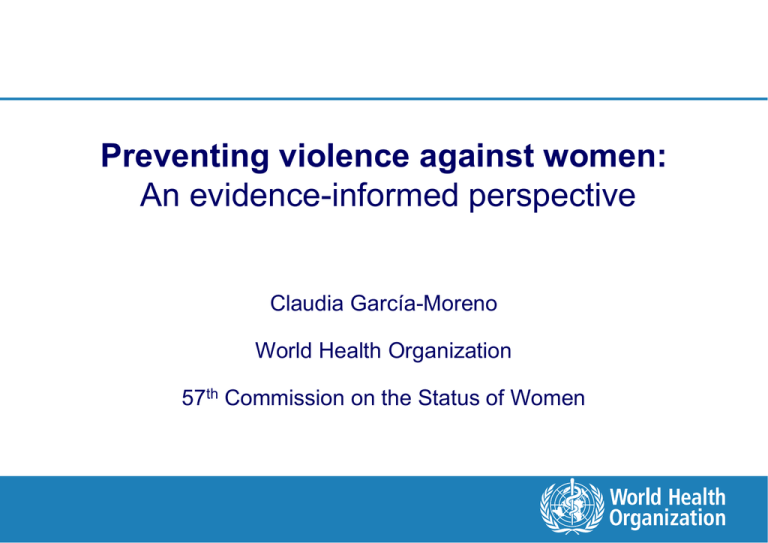
Preventing violence against women:
An evidence-informed perspective
Claudia García-Moreno
World Health Organization
57th Commission on the Status of Women
What do we know?
• More data than ever before, particularly on intimate partner
violence
• The causes of partner violence are multiple and intertwined –
factors interact at multiple levels to place women at risk of
abuse
• More knowledge of risk and protective factors and of
promising approaches to prevention
─ Interventions can reduce acceptability & levels of violence over
programmatic timeframes
• At country level, multiple entry points for intervention
Many risk factors for intimate partner
violence
Community level
Acceptability of wife beating
Norms supporting male authority / control
over women
Norms of family privacy/acceptability of
divorce
Lack of social sanction for violence
Individual & relationship
Experiences of childhood abuse,
growing up in violent household
Problematic alcohol use by male
partner
Acceptance of violence as means
to resolve conflict
Low education level
Societal level
Lack of economic rights & entitlements for
women, including access to formal wage
employment
Discriminatory family law & limited acceptability
of divorce for women
Inequality in access to higher education
Level of economic development
Intervening at different levels
Transforming harmful
gender norms:
Empowering women:
1. Integrated gender,
microfinance & HIV training
2. Securing property rights
3. Conditional Cash transfers
Socio-economic
conditions
Laws &
Policies
Promoting GE laws &
policies:
1. Laws against violence
2. Training law enforcement
3. National standards on postrape care
4. Reducing access to alcohol
Individual characteristics
and behaviour
Choice in partner(s)
Couples & families
Communities
Countries
1. Mass Media
2. Community mobilization
3. Peer and participatory education
with men and boys.
4. Gender equitable attitudes in
schools
Cultural &
Social Gender
Norms
What works to prevent partner violence?
Review evidence of association and promising interventions to
address:
•Social norms around gender and violence
•Women's economic and social empowerment
•Childhood exposure to violence
•Harmful alcohol use
• Legal and justice system interventions
1. Changing Social Norms
Evidence of link
•acceptability of violence
•male authority/dominance over women
Promising interventions
• Awareness campaigns – e.g. “We Can” , "It's Not Ok"
• Small group transformational change efforts, often supplemented with
community-based activities – eg Stepping Stones; Programme H;
IMAGE programme
• Social norms marketing and “edutainment programmes” e.g. Soul City,
Sexto Sentido; Breakthrough’s “Bell Bijao” Campaign
• Population level social change programming e.g. SASA!
Examples of prevention interventions
Community focused
• Soul City
• SASA! Uganda
Both sexes:
• Stepping Stones, S. Africa
• Sexto sentido, Nicaragua
Men
• Program H (Brazil)
• Yari Dhoshi (India)
• We Can
Women
• IMAGE
• SisterAct
• Program M
2.Women’s social & economic empowerment
Evidence of link
•Secondary education protective
•Employment, ownership or cash or assets may decrease risk
•Some effects context specific, depending on factors related to partner and/or
broader social norms
Promising interventions
• Evidence that combined livelihood & empowerment programmes achieve
impact (e.g. IMAGE, South Africa)
•Some evidence that economic empowerment interventions reduce violence,
although context specific
•Evaluation of impact of cash transfer programmes on partner violence are
just beginning
In South Africa combined micro-credit & gender training
intervention (IMAGE) cut levels of intimate partner violence
by a half over 2 years
Among participants:
•
Past year experience of IPV reduced
by 55%
•
Households less poor
•
Improved HIV communication
Among younger women:
•
64% higher uptake HIV testing
•
25% less unprotected sex
Pronyk et al. The Lancet Dec. 2006, Pronyk et al AIDS 2008
3. Childhood exposure to violence
Evidence of link
• Strong evidence that child abuse (physical and/or sexual) and witnessing
marital violence increase risk of perpetration
• Poor parenting and gender socialization help reproduce negative child
outcomes (including partner violence) across generations
Promising interventions
• Parenting programmes shown to reduce negative child outcomes,
including precursors to partner violence, in randomized studies
• Current programmes target harsh parenting, child maltreatment and
exposure to parental violence (home visitation)
4. Harmful use of alcohol
Evidence of link
•Not sufficient or necessary, but where present it increases frequency and severity
Promising interventions
•Early identification and brief counselling by health workers has been shown to reduce harmful
drinking
•Reduce alcohol availability
–
–
Recent studies from the US and Australia have found clear link between outlet density and
domestic violence
Meta-analysis of 122 studies confirms that increasing alcohol taxes decreases harmful drinking
•Community based interventions
•Alcohol misuse treatment has been shown to reduce frequency and severity of partner violence
5. Legal and justice system interventions
• Women’s police stations
–
Mixed evidence
• Informal justice and rights-based initiatives
– Novel strategies being applied in southern countries: mobile courts; working with village
dispute resolution systems need to be evaluated
• Protection Orders
– Research from the United States suggests that protective orders do reduce repeat
violence for some victims some of the time; no studies have evaluated protective orders
in southern countries
• Pro-arrest policies
– Arrest may have a modest effect on recidivism for some men, especially first-time
domestic violence offenders with no other history of criminal conduct
– No evidence outside of high-income countries
Recommendations
We need:
– national strategies that are tailored around a local understanding
of the problem
– to implement what works and theoretically-informed best
practice, using all entry points possible (building on strategic
opportunities of all agencies to achieve impact)
– to escalate intervention research
– to develop services for victims in tandem with rolling out
prevention interventions
– to ensure coordination across strategies for maximum impact
High level political support globally, nationally and within
communities is essential
Violence against women
is preventable.
Let's do it together!!
Sources and acknowledgements
WHO/LSHTM, 2010 Preventing
intimate partner and sexual violence
against women. Geneva: WHO
http://www.who.int/reproductivehealth/publications/vi
olence/en/index.html
Heise L, 2012 What works to prevent
partner violence
http://strive.lshtm.ac.uk/resources/what-worksprevent-partner-violence-evidence-overview
Acknowledgements
Lori Heise and Charlotte Watts,
Centre for Gender Violence and
Health, LSHTM

